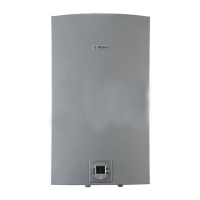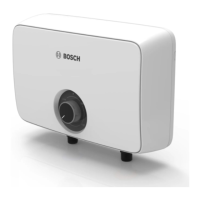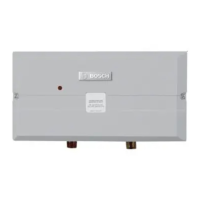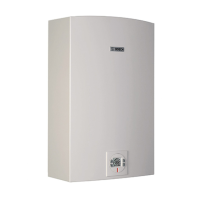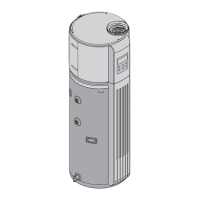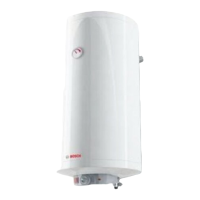Problem solving
C 950/C 1050 (Pro TL 175 C/199 C) – 6 720 805 440 (2019/10)
68
E9 Overheat sensor (ECO) open
circuit (resets when cooler
temperatures are detected
220°F/104 °C).
1. Disconnect power supply cord and check wire connections on the overheat
sensor (fig. 80, page 74) and the two connectors on the control board.
2. Check white wire connections at the overheat sensor. Clean terminals with an
eraser. If badly corroded, replace sensor and wire harness.
3. Check that venting specifications are met. Long vent lengths, venting with more
than three elbows, blocked vent or combination venting may cause this failure.
4. In areas where water has a high mineral content, periodic descaling may
necessary, see chapter 7.3, page 57.
5. Unplug power supply cord to the water heater. Open a hot water tap for several
minutes to allow cold water to pass through heat exchanger. Close hot water tap and
disconnect lead wires to overheat sensor. Using a multimeter, check continuity
through overheat sensor contacts. Replace sensor if open.
EA No flame ionization detected
with water flow.
1. Verify that all manual gas shut off valves are open.
2. Check gas type. See fig. 2, page 11.
3. Reset error code and open a water tap to cycle the heater in an effort to purge air.
Cycling hot water tap on and off multiple times may be necessary. If heater still faults
with EA error code, have a licensed gas technician properly purge air out of the gas
line leading to the water heater.
4. Check three wire connections on the lower front of the heat exchanger are secure.
5. Check gas pressure. See chapter 4.14, page 49.
6. Check venting specifications are met. Improper venting may cause premature
failure of the flame sensor rod. See chapter 4.3, page 15.
7. Check that the minimum power fan speed has been adjusted to the proper value.
See page 32.
8. Observe inside the viewing window of the heat exchanger when a hot water tap is
opened. Sparking should be followed by a steady blue flame. If flame is unstable/
yellow with proper gas pressure, confirm CO
2
readings per chapter 7.5, page 59.
EC Ionization failure during
operation.
1. Check gas type, fig. 2, page 11.
2. Check three wire connections to ignition group on the lower front of the heat
exchanger are secure.
3. Verify that venting specifications are met. Improper venting may cause premature
failure of the flame sensor rod. See chapter 4.3, page 15.
4. Check gas pressure. See chapter 4.14, page 49.
5. Check and adjust CO2 readings. See chapter 7.5, page 59.
6. Check that the minimum power fan speed has been adjusted to the proper value.
See page 32.
Display Cause Solution

